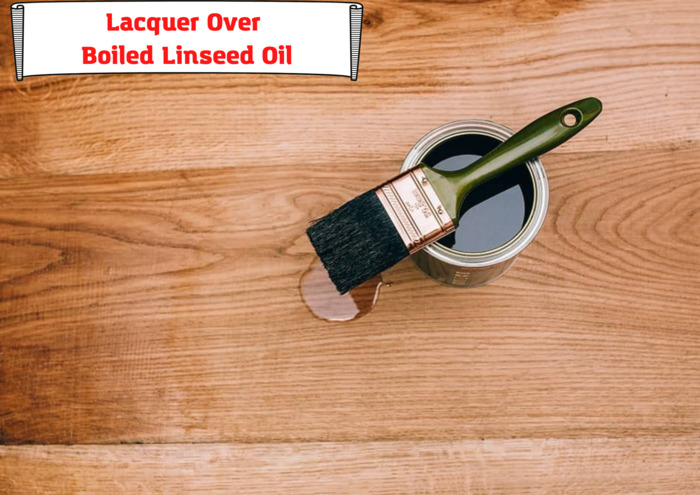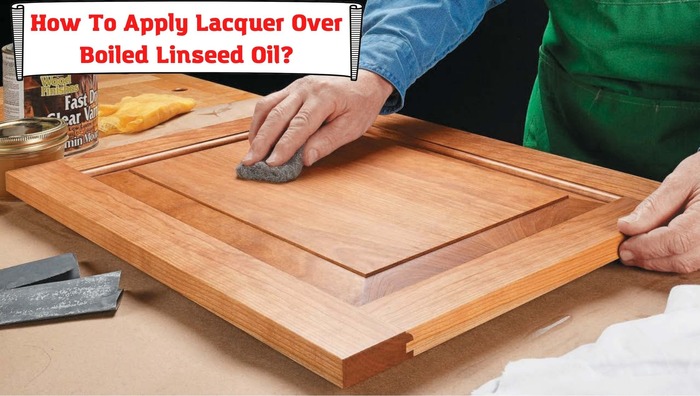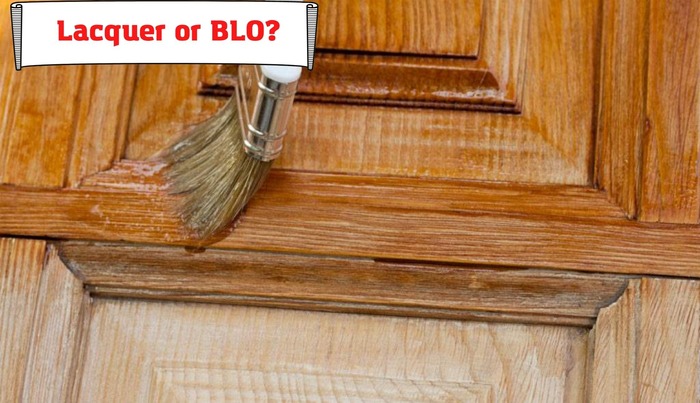
Furniture wood needs protection as it’s too easily damaged if left in its natural state. There are many protective finishes that you can use to preserve wood, including shellac, wax, lacquer, penetrating resin, oil, and varnish. Sometimes you may require using more than one finish, one on top of another, for more elaborate results. However, there may be compatibility issues between one finish and the other. That brings us to our topic of discussion today.
Is it okay to apply a coat of BLO and then lacquer on top of it? What effects would that have on the wood? What are the steps of doing this? So, keep reading for these and other things that you should know.
Is It Okay to Apply Lacquer over Boiled Linseed Oil?
Boiled linseed oil is drying oil. Such oil dries to form a hard film upon exposure to oxygen. The hardening process is a chemical reaction referred to as polymerization.
That’s aside, the short answer to the question is yes: you can topcoat boiled linseed oil with lacquer. Accentuating wood grain with BLO and then coating with lacquer will provide a far better finish than oil alone. Lacquer produces a very appealing finish when applied over boiled linseed oil.
The secret behind success in this is to first allow the oil to dry fully. Once the oil has dried, it will have cured to a hard film surface, meaning that lacquer will stick perfectly. We recommend that you let the oil dry for 2 to 5 days depending on the weather. Wait for 2 to 3 days on warm days or 4 to 5 days during cool days. Once the oil has dried; you should seal it with a vinyl sealer and then apply lacquer on top.
Some of the woodworkers we’ve spoken to have reported adhesion issues with putting lacquer over BLO. But as mentioned above, many have learned that the secret to success is to let the oil fully cure first. The time you give the oil to cure will depend on the weather. If it’s cold, then you can wait for up to a week. Giving it up to two weeks can give you even better results.
Note: We’ve not found many professional woodworkers who have used water-based lacquers on BLO so far. So, we can’t offer any advice on that for now.
How To Apply Lacquer Over Boiled Linseed Oil?

A coat of lacquer over BLO finish will enhance the beauty and depth that the slow curing oil offers while obtaining the protective property of lacquer. Thus, as we have explained above, it’s a good idea to topcoat boiled linseed oil with lacquer. So, how should you go about it?
Step One: Sand Wood to 320
Start by sanding your wood to 320. Using a rag, apply a thin coat of BLO and then allow it to sit for 15 minutes. Wipe off any excess oil from the surface. The oil will dry in the wood and not on it when you do that.
After that, you should allow the first coat to dry for 2-5 days depending on the weather (explained above). You can place the furniture piece in a heated room to dry quickly if you don’t want to wait all that long. The room should have a temperature of approximately 75 degrees.
If you’ve got a garage shop, try creating a drying area – large or small depending on your needs. You can frame the area with some 2 x 4’s and then secure them with poly sheeting (4 Mil Plastic Sheeting). After that, seal the edges using duct tape to help trap heat inside.
But, there’s an easy way. A professional woodworker we talked to told us that he used an electric oil heater to keep his room at optimum temperature.
Step Two: Sanding Sealer
Once BLO has dried, you’re good to spray a coat of lacquer on top. That should be the next morning if your furniture had a facilitated drying – as explained in step one. With natural drying, you should give the oil enough time to dry – explained above also.
Before that, you may need to apply a sanding sealer, which is the lacquer’s primer. This sealer features stearic acid that helps to soften and make it sand more easily. You should always apply sanding sealer in thin coats. In that case, you just need to apply one coat thinned using lacquer thinner. Using the sealer will help lacquer bond perfectly to the wood.
Some expert woodworkers prefer using a vinyl-based sanding sealer as it’s more water-resistant than the standard sealer. You just need two coats and then sand the surface using 320 grit paper.
Step Three: Applying Lacquer
Allow the sanding sealer to sit for about 2 hours and then apply or spray a coat of lacquer. After about an hour, spray as many coats as you need. Every time you put on a coat, the gray color will dissolve for 10 to 15 minutes. As the liqueur dries, the color will come back, and every coat will be doing the exact same thing.
However, your wood can obtain good protection with just a few lacquer coats. Alternatively, you can sand the surface at 320 and continue adding more coats. The more sanding and coating you do, the better the grains become aligned. You’ll be closer to a glass-like finish (Piano finish) by the time you’re applying 15 to 20 coats. But of course, this isn’t necessary in most cases.
It means applying about 3 coats followed by light sanding in between the coats daily. That will fill the pores well and scuff the surface to allow the solvents to evaporate faster. In the end, your wood will have a smooth finish and all you’ll need is to give it enough time to cure completely.
That might take between two weeks and one month depending on the weather. After that, you can wet sand and rub it out to a glossy reflection. The lacquer finish will shrink as it cures. For this reason, we advise that you test the coats by pressing the surface with your fingernail. See if finish dents. If it can dent, then give it time for more drying. Wait until you when you can’t dent the finish with light pressure.
Apply the next coat once satisfied that the surface is dry. We recommend that you first do the testing on some small wood pieces. You can also write notes, including the date of each coat you apply on the back. That will ensure that you get excellent results when you start working on the main project.
Do You Still Have Doubts About Adhesion Between Lacquer and BLO?

Here’s what you should do if you’re still not confident that lacquer can stick well on BLO. The next day after “Step One” above, rub your wood with suitable steel wool. The steel wool should be consistent enough without oil in its fibers. Make sure that you rub hard to extract the finish so that the surface appears as if it’s dry. Remember BLO is penetrating oil and there will still be enough oil soaked in the wood creating a smooth sheen.
Blow off the dust with compressed air and then shoot a coat of ARM-R-Seal Satin. The finish comes with urethane in it and also dries more quickly. Apply more oil sparingly in case the resins begin to form on the surface. The oil will help dissolve any sticky residue so that you can wipe, buff, clean, and dry the surface.
Now allow time for this coat to dry. After that, wipe a thin coat of dewaxed shellac, and then apply lacquer on top. In this case, the shellac will serve as a sanding sealer or seal coat. We emphasize that you use dewaxed shellac to ensure that your lacquer top coat adheres well.
Shellac is very forgiving and will do just fine on almost all finishes. Many woodworkers, however, aren’t fun of it for some reason. But you can apply it underneath another protective finish without a problem. The coat of shellac will increase the compatibility between BLO and lacquer. Apply lacquer finish once shellac has dried overnight. Although many might prefer polyurethane, shellac is far much better in terms of adherence and overall wood appearance.
Final Thoughts
Lacquer over boiled linseed oil gives your wooden furniture a more protective and glossy finish that BLO alone can’t achieve. However, it requires a lot of care to ensure that both finishes adhere well to each other. Fundamentally, you need to ensure that the coat of BLO has dried well before shooting coats of lacquer on top. Allowing enough time for the oil to dry properly is the secret behind obtaining good results.
Applying lacquer over BLO is a simple 3-step process but one that requires a lot of caution and patience. You can use shellac to enhance compatibility between BLO and lacquer. That is, apply a thin coat of shellac over BLO and then topcoat it with coats of lacquer. Remember to do testing first before embarking on the main project.
- How Long To Wait Before Sanding Acrylic Enamel Paint? Quick Tips - January 31, 2022
- Lacquer Over Boiled Linseed Oil. Things You Should Know - January 30, 2022
- Shellac vs Danish Oil. We’ve Found Out Which One Is Better - January 25, 2022



